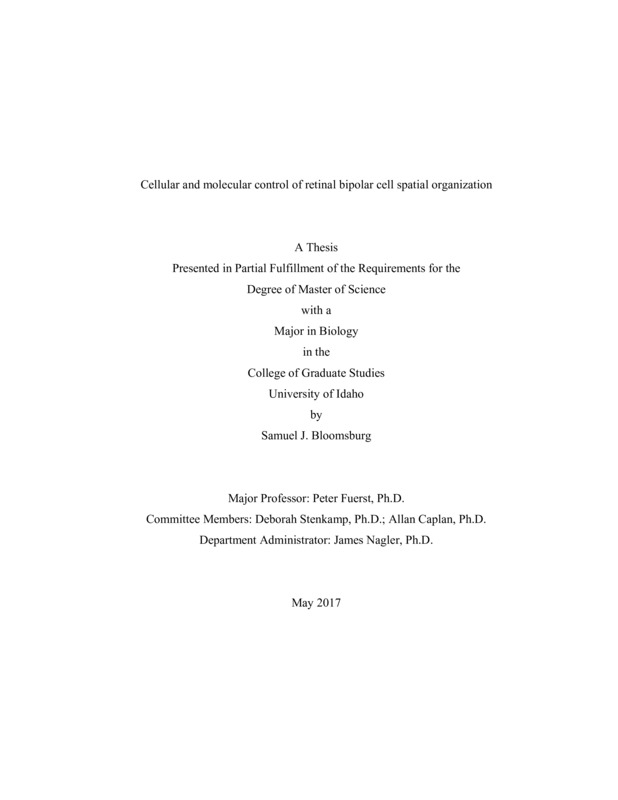Cellular and molecular control of retinal bipolar cell spatial organization
Bloomsburg, Samuel Jesse. (2017). Cellular and molecular control of retinal bipolar cell spatial organization. Theses and Dissertations Collection, University of Idaho Library Digital Collections. https://www.lib.uidaho.edu/digital/etd/items/bloomsburg_idaho_0089n_11141.html
- Title:
- Cellular and molecular control of retinal bipolar cell spatial organization
- Author:
- Bloomsburg, Samuel Jesse
- Date:
- 2017
- Embargo Remove Date:
- 2019-06-12
- Keywords:
- bipolar cell development Retina vision
- Program:
- Biology
- Subject Category:
- Biology
- Abstract:
-
The retina is a part of the central nervous system, located within the eye, responsible for detecting and processing the light that passes into the eye. It is contains a huge number of neurons for its size, is highly organized, and is, gram for gram, the most metabolically active tissue in the body. The retina begins development as a clump of neural progenitors pinched off from the anterior end of the neural plate, and ends development with more than 50 cell types, each of which organizes itself with respect to cells of the same type, and with specific afferent and efferent neurons. Proper function of the retina, and hence vision, depends on this organization.
To understand how this organization emerges and is maintained, our lab has taken a genetic and developmental approach to investigating the factors that contribute to patterning and growth. In this work, we investigate the 1) Down syndrome cell adhesion molecule (DSCAM), which has been implicated in developmental cell death, axon guidance, and avoidance and repulsion, and 2) a form of growth-limitation over development which we believe contributes to the accuracy of visual information transmitted by retinal bipolar cells.
In chapter 1, we show that Dscam mediates homotypic avoidance during development, and show that it affects neural plasticity in adulthood.
In chapter 2, we present a novel form of growth-limitation. Here we find that bipolar cell axon arbors correlate in size with bipolar cell dendrite arbors. We also find that bipolar cell dendrites do not sample all cones in the retina, and the pattern in which they leave space “un-sampled” is recapitulated by bipolar cell axons, which leave “un-sampled” regions of their own in their own synaptic layer.
In chapter 3, we present a transgenic Cre line, Pou4f2-Cre, which we believe to be a useful tool for vision researchers, including ourselves.
- Description:
- masters, M.S., Biology -- University of Idaho - College of Graduate Studies, 2017
- Major Professor:
- Fuerst, Peter G
- Committee:
- Stenkamp, Deborah; Caplan, Allan
- Defense Date:
- 2017
- Identifier:
- Bloomsburg_idaho_0089N_11141
- Type:
- Text
- Format Original:
- Format:
- application/pdf
- Rights:
- In Copyright - Educational Use Permitted. For more information, please contact University of Idaho Library Special Collections and Archives Department at libspec@uidaho.edu.
- Standardized Rights:
- http://rightsstatements.org/vocab/InC-EDU/1.0/

